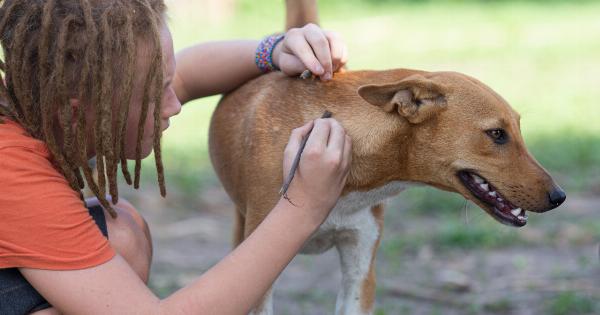It can be concerning and confusing to witness your beloved furry friend tremble for no apparent reason. As a responsible and caring dog owner, it’s essential to understand the underlying causes of this behavior.
Trembling in dogs can occur due to various factors, ranging from anxiety and fear to pain or health conditions. In this article, we will explore some possible reasons why your dog may be trembling and offer suggestions on how to alleviate their distress.
1. Anxiety and Fear
Dogs can experience anxiety and fear just like humans. They may tremble when faced with certain stimuli or situations that make them feel uncomfortable or stressed. Common triggers of anxiety or fear in dogs include:.
• Thunderstorms.
• Fireworks.
• Loud noises.
• Separation anxiety.
• New environments or people.
If you notice that your dog trembles primarily in the presence of these triggers, it’s likely that their trembling is related to anxiety. Providing a safe and calm environment for your canine companion is crucial.
Consider creating a designated safe space for your dog during thunderstorms or fireworks, using canine anxiety wraps, or exploring behavior modification techniques recommended by a professional dog trainer to help alleviate their anxiety.
2. Pain or Discomfort
Dogs may also tremble when they are in pain or experiencing discomfort. This can be caused by various factors, including:.
• Injury or trauma.
• Arthritis.
• Dental problems.
• Digestive issues.
• Neurological conditions.
If you suspect that your dog’s trembling is due to pain or discomfort, it is essential to seek veterinary attention promptly. The veterinarian can conduct a thorough examination and perform necessary tests to identify the underlying cause.
Once the cause is determined, appropriate treatment can be prescribed to relieve your dog’s pain and alleviate the trembling.
3. Hypoglycemia
Hypoglycemia, or low blood sugar, can occur in dogs and lead to trembling. This condition is more common in small dog breeds and puppies. Dogs with hypoglycemia may exhibit other symptoms such as weakness, lethargy, confusion, and lack of coordination.
If your dog’s trembling episodes are accompanied by these symptoms or if you suspect hypoglycemia, it is important to seek veterinary assistance immediately.
The veterinarian can perform tests to diagnose hypoglycemia and provide appropriate treatment, such as adjusting your dog’s diet or administering glucose supplementation.
4. Age-Related Trembling
Trembling can be more prevalent in senior dogs due to age-related factors.
Older dogs may experience muscle weakness, degenerative joint diseases, or conditions like canine cognitive dysfunction (similar to Alzheimer’s in humans), which can contribute to trembling.
If your senior dog trembles regularly without any apparent underlying cause, providing them with a comfortable and supportive environment becomes essential.
Consider providing orthopedic bedding, gentle exercise routines, and enriching mental stimulation activities to improve their overall well-being.
5. Side Effects of Medications
In some cases, trembling in dogs can be a side effect of certain medications. If your dog has recently started a new medication and you notice trembling, consult your veterinarian.
They may recommend adjusting the dosage, prescribing an alternative medication, or monitoring the situation further.
6. Poisoning or Toxicity
Ingestion of toxic substances can lead to trembling as one of the initial symptoms.
Common household items that are toxic to dogs include certain plants, chocolate, certain medications (such as non-steroidal anti-inflammatory drugs), and cleaning products. If you suspect your dog may have ingested something toxic, contact your veterinarian or an animal poison control hotline immediately for guidance.
7. Tremors or Seizures
In some cases, dogs may experience involuntary tremors or seizures. Tremors are rhythmic and repetitive movements, while seizures involve uncontrolled muscle activity, loss of consciousness, and other severe symptoms.
If your dog’s trembling episodes resemble either of these situations, it is vital to seek immediate veterinary attention for proper diagnosis and management.
8. Underlying Health Conditions
Trembling in dogs can also be a symptom of underlying health conditions. Conditions such as kidney disease, liver disease, heart problems, and hormonal imbalances may manifest as trembling.
If your dog’s trembling is persistent or accompanied by other concerning symptoms, consult your veterinarian for an accurate diagnosis and appropriate treatment plan.
9. Temperature Regulation
Dogs may tremble or shiver to regulate their body temperature. This behavior is particularly common in smaller dog breeds or those with shorter hair coats.
If your dog’s trembling is accompanied by exposure to cold temperatures or obvious signs of discomfort, consider providing a warm and cozy environment to keep them comfortable.
10. Stress and Excitement
Lastly, dogs may tremble due to excessive stress or excitement. This can occur during highly stimulating events, such as visits to the veterinarian, car rides, or encounters with new people or animals.
In these situations, the trembling is usually temporary and subsides once the event or situation has passed.
It’s important to note that the information provided in this article is not intended to replace professional veterinary advice.
If your dog trembles for no apparent reason or you have concerns about their well-being, it is always best to consult with a qualified veterinarian to determine the cause and appropriate course of action.





























